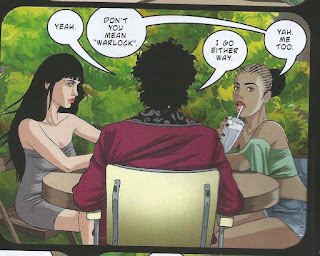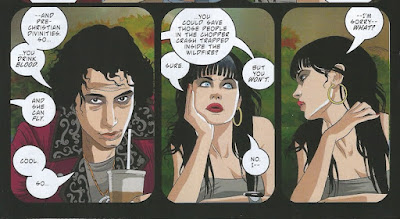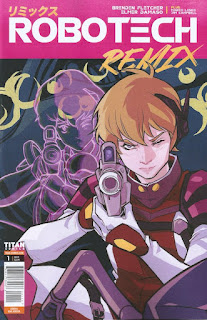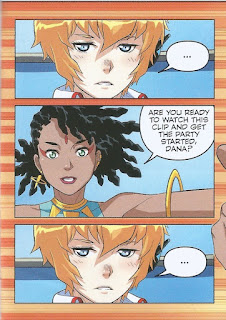Pick of the Brown Bag
October 16, 2019
by
Ray Tate
Salutations. It’s time once again for the Pick of the Brown Bag, a weekly comic book review blog owned and operated by yours truly. This time around we look at Aquaman, Batman, Captain Marvel, Contagion, Robotech, Steeple, Superman Smashes the Klan, Vampirella and Wonder Woman Come Back to me. The tweets are already available under: #PickoftheBrownBag
Contagion keeps on giving. One might say it’s infectious. Last issue, more heroes succumbed to the semi-intelligent fungus that originated in K’un-Lun. Power Man’s wife is not happy.
As stated in the previous review, I have zero love for Jessica Jones, but this scene was pretty funny and rings true. I read the first volume of Iron Fist. Danny Rand wasn’t irresponsible, but he wasn’t exactly Captain America either.
Danny takes Jessica's threat seriously. He's on babysitter duty. Of course he finds a loophole to wriggle through. He takes Jessica's daughter Dani with him when consulting magicians playing poker.
Fan-tastic! Only Dr. Strange and Clea hold a candle to DC’s magic users. Even so, I’m pretty certain that even Sargon the Sorcerer can paste him.
When the Crisis on Infinite Earths struck. The enchanters of DC Comics banded together in a show of impressive force.
I have no idea who these Marvel practitioners are, or even if they ever appeared before, but their low-rent participation is a hilarious spoof. It’s like sending Dr. Nick to face the Incredible Melting Man.
The inclusion of a Doug Henning analogue is a massive bonus. Doug Henning delighted audiences all over the world in the 1970s with masterful illusions.
More fan-favorite heroes drop in to lend a hand while writer Ed Brisson readdresses the Fantastic Four’s plight and gives Thing fans a real treat.
Contagion is a self-contained Marvel hootenanny with an easy to understand threat and a satisfying blend of comedy and superhero action.
Kelly Thompson reveals Captain Marvel’s secret superpower. She’s resistant against shock. For example, say you want to punch a hole in your chest. Just for fun.
You had better be resistant to shock. Shock is the body’s means of communications. It tells the owner. Don’t ever do this again. Shock occurs when the body is mortally injured and can actually be more damaging than the original blow. So, if Captain Marvel can punch a hole in her chest and get up afterward, she’s resistant to shock.
Captain Marvel is punching holes in her chest because Kree mad scientist Dr. Minerva infected her with nano machines that built a device inside her body. The machines also integrated the mech with her physique and metabolism. Thus, Carol until recently had no idea that a somewhat large gizmo siphoned off her power to new hero named Star.
Star’s identity is the solution to a mystery that I didn’t know unfolded. So, although I don’t understand the import of the revelation, it doesn’t actually affect my judgement.
Ultimately, Captain Marvel left me lukewarm. I just have a hard time suspending my belief for the multiple scenes of chest-smashing.
That said, Thompson does several positive things. She believably dispenses with the I-hate-Kree march that was going on. Reverses pretty much every crappy thing done to Carol. Hazmat gets a good moment. Carol’s old friends like Iron Man and Spider-Woman stick by her. Thompson also believably rekindles Carol’s romance with Jim Rhodes. So, not a total wash.
In Amanda Conner’s and Jimmy Palmiotti’s Wonder Woman Come Back to Me, Diana got sucked into a strange island in the Bermuda Triangle while searching for Steve Trevor. On the island, she meets an alien Princess, her old nemesis the Cheetah and of all people Jonah Hex, amidst even more unusual denizens. In this issue, the writing partners demonstrate Diana’s intelligence and not just her Amazon strengths.
She however may not have time to exploit that knowledge. Since the aliens whom we’ve met before return to capture their bounty.
Benefitting from strong writing, Come Back to Me also merits through two superb art teams: Chad Hardin and Tom Derenick with Alex Sinclair and Jeremiah Sinclair. Though the styles differ, they mesh quite well.
Chad Hardin could have probably illustrated the whole shebang, but given the nature of Wonder Woman’s extraterrestrial foe, Derenick’s presence is quite apropos.
Specifically for Wonder Woman fans, the creative unit evolves a potent miniature duel between Cheetah and Wonder Woman.
This is much more fitting than that off putting…petting scene from Greg Rucka’s and Liam Sharp’s Wonder Woman a couple of years ago.
Aquaman is an interesting beast that’s split into three parts. Two of these sections work smoothly together to relate a richly illustrated Weird Tale.
The gist is about the founder of Amnesty Bay Tristram Maurer who appears to be immortal. He’s the imaginer of monsters.
Unfortunately they manifest in real life. Last issue Aquaman and new Aqualad fought a doozy.
Aquaman serves as the witness to Maurer’s tale of madness. DeConnick surrounds the maelstrom with a cast of Aquaman stalwarts: Aquaman’s high school friend Erika Watson, her beau Dwayne, Tula the ex-Regent of Atlantis and cousin to Aquaman and new Aqualad Jackson Hyde, the son of Aquaman’s arch-nemesis Black Manta.
Black Manta appears in the “Year of the Villain” section of the story, and though this features Mera, the modern Atlantean Klingon Murk and a very Bronze Age Vulko, it’s tangential to the main tale.
That doesn’t mean it’s bad. It’s pretty hard to be angry or disdain over Black Manta attacking Amnesty Bay with a giant robot that’s run by an A.I. based on his dead father’s brainwaves. Manta’s dad incidentally tries to talk some sense in his boy. Alas, Manta’s having none of it.
John Allison’s Steeple is a rather charming British comedy with monsters and satanists. The Reverend Penrose has been fighting sea beasts and the like for years. He’s asked for help. The Diocese sent initiate Billie Baxter. Though she assisted Penrose when taking out a creature, this issue she has other fish to fry.
That’s right, Billie actually wants to promote altruistic and philanthropic behavior. Unfortunately, her bike is giving her some difficulty.
The Reverend Billie takes it as a sign, but her audience is less than enthusiastic.
This warrants talking with Maggie whom she met when her car exploded. Maggie is a satan worshipper, but a friendly one.
With this in mind, Billie tackles the village’s youth another way and succeeds on both fronts. This ironically creates conflict from Penrose who learns a lesson.
Allison perhaps felt that the story however genuinely warm and funny was a bit too much Afters School Special. So he concludes with a comedic epilogue in which Billie’s shot down out from her certainty.
Christopher Priest’s Vampirella has been a terrific addition the canon of V’s adventures. Priest tackled the issue of V’s many origin iterations, sifted through them and found something unique to contribute. He also took the Tom King route by reincorporating most of Vampirella’s history. Although he’s got an easier time of it since Vampirella is immortal.
There’s a lot in this issue that I don’t understand. I have no idea what Vampirella’s enemies are up to in the opener. That obfuscation though I feel is meant.
I haven’t a clue as to why Vampirella’s writhing, wincing or cringing on an altar. It’s something to do with one of the Marys being in love with her, but if they’re having sex its too subtle for me.
My first thought was the scene presented Mary’s vision, but Vampirella relates the story. So how can she clue in on Mary’s thoughts and desires?
Despite these moments of confusion, the core of the book is much stronger and easier to comprehend. The dialogue is also more explicit and the maturity not in the skin quotient but the frankness of sexuality. Vampirella and her newly acquired girlfriend Rosette confront an odd bloke named Benny a libertine who dabbles in the occult.
Vampirella met him when she and the Marys broke up a satanic sex party that was actually unbeknownst to many of the participants a front for a dinner party. In which the host intended to serve up the guests. Bon Apetit.
The conversation turns into what Benny believes is a philosophical discussion. When in fact it just exposes Vampirella not being aware of the situation.
Priest then presents Vampirella as a bona fide superhero. Who though not possessing a cape sprouts Bat Wings which are just as good.
V scours the burning countryside for survivors and resists the temptation of demons while Daktari finds the whole idea of a vampire risking her life to save humans incredulous. That of course is the secret of Vampirella’s staying power. Sure, she’s drawn to arouse, but ultimately, it’s the uniqueness of Vampirella, the first genuinely good vampire in literature that grants fascination.
Batman and Catwoman attempt to infiltrate Arkham Asylum. First they need to get past the once one-hit wonder Amygdala and Solomon Grundy. This allows for John Romita Jr. and Klaus Janson to beat out an impressive martial arts visual narrative that’s juxtapose with Tom King’s point of view narration.
Batman reveals most of his plotting to fight Bane. As I surmised, Batman did indeed plan at least ten steps ahead to fight Bane. However, not everything went to plan. Batman’s dishevelment for example not part of the plan.
So Catwoman did indeed save Batman’s life. Her appearance was fortuitous. The whole thing does make sense. While Batman calculated a beating, he didn’t expect to be this hurt. He also failed to calculate infection and other vagaries of injury. Tom King’s Batman is human after all.
As this occurs, the Batman Family attack Bane’s highly unexpected partner in crime, and Batman reveals one of the aces he held up his sleeve.
How could Superman Smashes the Klan be bad? It’s a modern adaptation of the radio series in which the powers behind the show actually revealed the secrets of the Ku Klux Klan, courtesy of Stetson Kennedy and perhaps others that infiltrated the organization.
Names, secret signs and rituals broadcast on the airwaves to inform the listeners of an insidious racist organization that sought to overthrow a country based on tolerance. Yes. Once long ago, people tolerated each other even if they didn’t particularly like one another.
Though the actual nature of the revelations came into question, what cannot be denied is that The Adventures of Superman did indeed air a sixteen part serial in 1946 called “The Clan of the Fiery Cross” in which Superman beat the crap out of the Klan. Superman pissed off the real-life Klan who demanded a boycott of the show. Which sucks for them since, the series lasted a good four years before becoming George Reeves’ Adventures of Superman television series.
Writer Gene Luen Yang’s story begins with a prototypical 1940s Superman prologue.
Oh, yeah. Nothing says America like Superman beating up a Nazi out for revenge. World War II is long over just as in the radio serial. The scene is buoyed by a super spunky Lois Lane and a good cub reporter version of Jimmy Olsen.
A cakewalk Nazi whack-a-mole turns almost deadly when Superman suddenly discovers Kryptonite.
The black gentleman is Inspector Henderson. Yang likely introduced kryptonite in his story because the radio serial debuted the concept. Siegel and Shuster nevertheless created kryptonite in an unpublished story.
Superman will also discover his alien origins in the tale, and this will play a part in the lives of a Anglo-Saxon-Chinese family just moving to Metropolis.
Yang doesn’t just target the Klan. He also brings up assimilation. The Chinese mom, who’s unfortunately unnamed, must speak broken English in public and refer to her kids by their anglicized names.
Lan-Shin or Roberta is a little girl who loves her big brother Tommy. Tommy quickly gets picked up on Jimmy Olsen’s baseball team, and that’s where the whole Klan attack starts.
Because of a baseball game, the Klan goes on the offensive. They start with a warning.
They move on to attempted murder. The whole thing would have gone badly if not for the fact that this is a Superman comics book.
Jeffrey and Susan Bridges’ Killswitch with art by Red Sonja’s Walter Geovani posits an edgy future world set in colonized space.
This however is not the Federation. Rather, it’s a militarized police state in which the cops hunt and capture Augers.
Yes, they spell the name differently, but it amounts to the same thing. Remote viewing nonsense. Only it’s a comic book, so some humans can see the future.
Unfortunately, the ruling majority reclassify these people as second class citizens and a disposable commodity.
Killswitch is a strong statement against xenophobia. The Augers look like their captors. They behave like humans. They even dress the same as the military. In many ways, they parallel the black military units of the world wars. Only in these eras, blacks volunteered for service. Killswitch spans the historical record of slavery.
A long time ago, I would race home from school to watch a series of Japanese cartoons edited together to form one Robotech under God. The second Robotech series introduces Dana Sterling commander of the Southern Cross and daughter of the first saga's two top pilots Max Sterling and the Zentradi enemy pilot Miriya.
Robotech spawned books and comic books before. A lot of the media just novelizes what's on screen, expanding on certain moments here and there. Titan's Robotech differs by being set in an alternate universe. Faithful readers of the POBB know that I love alternate universes. What many people do not know is that I love Dana Sterling.
Dana Sterling in previous issues of Robotech "fell" into the alternate universe. One of the more interesting items is that everybody knows she's from an alternate universe. In a totally anime themed moment, pop talk show host Anna brings a reluctant Dana Sterling on stage.
It's a little disheartening to see Dana so dejected. Dana is a firebrand and tactical genius in the second series of Robotech. She is the most unmilitary of the military. Still, her sadness is understandable. She's lost everybody.
The adult Bowie Grant was one of Dana's oldest friends. In this alternate universe, he's just a child, and Dana's mother is young and childless. She's also a helluva proponent of tough love.
We get a glimpse of old Dana when the SDF-3 captained by Lisa Hayes detects a new multiverse breach. This one's big.
Robotech is nostalgia done right. It presents a new adventure adhering in the universe that we never knew we loved. Starring Dana Sterling, a character from the universe we really do love.










































No comments:
Post a Comment